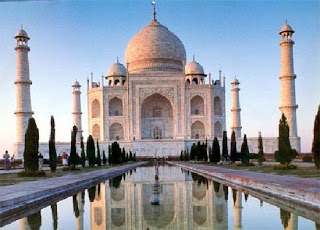 |
| Taj Mahal |
Taj Mahal is known as an example of Indian Muslim architecture. In addition, the Taj Mahal is remembered as a symbol of eternal love of Emperor Shan Jahan for his wife Mumtaz Mahal. Taj Mahal is a symbol of love and hasarat.
Taj Mahal was built into the fifth Mogul emperor between the years 1631-1648 to commemorate, Arjuman Bano Begum, better known as Mumtaz Mahal.
Initially, Shan Jahan mosque just mention it only as the tomb of Mumtaz Mahal, but it eventually evolved into the Taj Mahal. Taj Mahal when translated means "Crown Palace", an extension of the name of Mumtaz Mahal who came from Persia.
Mumtaz Mahal died at the age of 39, when giving birth to 14th child in 1631. The Empress's death was made the king so grieved. Before he died, Mumtaz told "the tomb to be made that the world had never witnessed before in his memory".
Ustaz Ahmad Shah Jahan ordered the construction of this form. Ust Ahmad gather 20,000 people comprising workers than the mason, the goldsmith, and engraver dunia.Arsitek famous of all the most skilled, inlay craftsmen, calligraphers, stone carvers and masons came from all over India and the region as far away as Persia and Turkey. Master mason was from Baghdab, an expert in building the double dome from Persia, and an inlay specialist from Delhi.
With the tube, the dome and minarets of white marble than done, as well as a beautiful art mozek, Taj Mahal is one thing rather than the Seven Wonder of the world. A total of 43 kinds of precious stones, diamond inclusion, jed, crystal, topaz and Patchouli has been used. Taj Mahal to swallow the coaching for 22 years
Building materials imported from all over India and Central Asia with 1000 elephants. The main dome and stand 57 meters.
28 beautiful stones from various parts of Asia use. Like the red sandstone of Fatehpur Sikri, jasper from Punjab, jade and crystal from China, turquoise from Tibet, lapis lazuli and sapphire from Sri Lanka, coal and stone kornelian of Arab, and diamonds from Panna. The floor was made of a luminous marble of Makrana, Rajasthan.
Unlike other Mughal tombs, the Taj Mahal garden in front of the tomb. Taj Mahal is the background of the sky, so the Taj Mahal looks so sparkling with color. The composition of shapes and lines perfectly symmetrical
Taj Mahal combines Persian art forms and traditions of the early Mughal art. Special inspiration comes from the Mughal dynasty theTimurid and buildings including; Gur-e Amir (the tomb of Timur, pengasas Mughal dynasty, in Samarkand), Humayun's tomb, the Tomb of Itmad-Ud-Daula (the so-called Baby Taj), and Jama Masjid. While earlier Mughal buildings are usually built of red sandstone, Shah Jahan advocated the use of white marble decorated with stone separa-value, and buildings in its shade reaches a new stage of refinement.
Permalink : Biography / History of Taj Mahal
Sharing Caring :
0 comments:
Post a Comment